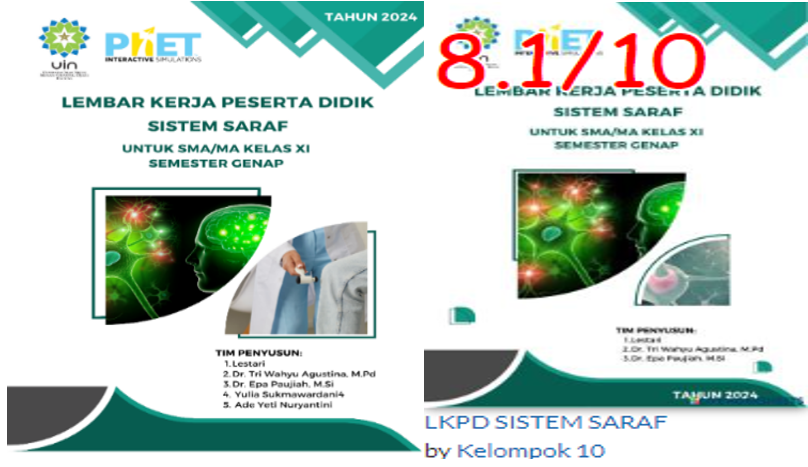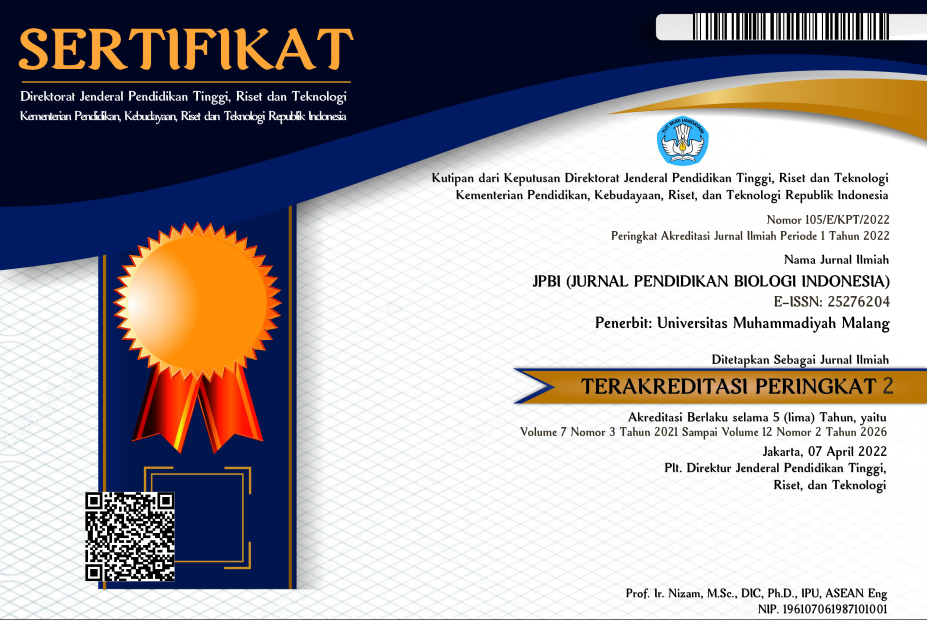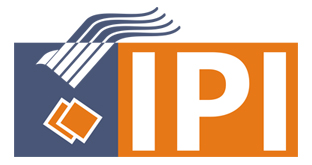Development of PhET-assisted simulation e-worksheet using flipped laboratory approach for science communication skills
DOI:
https://doi.org/10.22219/jpbi.v10i3.36162Keywords:
E-Worksheet, Flipped Laboratory, Science Communication Skills, PhET-Assisted Simulation, Nervous SystemAbstract
Communication skills are one of the 21st century skills. Specific communication in biology learning includes science communication. The purpose of the study was to analyze the improvement of science communication skills using E-Worksheet assisted by PhET on nervous system material. This research and development consist of three stages: the preliminary study stage, the product development stage and the product testing stage. Static-Group Pretest-Posttest research design. This study involved 35 students in the experimental class and 35 students in the control class selected using Purposive Sampling. The research instrument consisted of a validation questionnaire and limited description with indicators of science communication. Data analysis informs that e-worksheet is very feasible with an average score of 83.83%. The improvement of science communication skills on the nervous system material in the classroom using e-worksheet assisted by PhET simulation with an overall N-Gain value of 0.56 with moderate criteria. E-Worksheet assisted by PhET simulation helps the learning process. The guide to using E-Worksheet assisted by PhET simulation should be clearer and more detailed and provide training for teachers to be more familiar with electronics.
Downloads
References
Ahmadi, M. R. (2023). The use of technology in english language learning. International Journal of Research in English Education, 1(1), 432–433. https://doi.org/10.47689/xxia-ttipr-vol1-iss1-pp432-433
Amin, B. D., Sahib, E. P., Harianto, Y. I., Patandean, A. J., Herman, H., & Sujiono, E. H. (2020). The interpreting ability on science kinematics graphs of senior high school students in South Sulawesi, Indonesia. Jurnal Pendidikan IPA Indonesia, 9(2), 179–186. https://doi.org/10.15294/jpii.v9i2.23349
Amini, F. N., Roektiningroem, E., & Wilujeng, I. (2022). Development of student worksheet based on guided inquiry assisted by Phet simulation to improve concept comprehension. Journal of Science Education Research, 6(1), 46–50. https://doi.org/10.21831/jser.v6i1.48244
Arikunto, S. (2010). Prosedur penelitian suatu pendekatan praktik. Rineka Cipta. https://cir.nii.ac.jp/crid/1130000795354347648
Bei, E., Argiropoulos, D., Van Herwegen, J., Incognito, O., Menichetti, L., Tarchi, C., & Pecini, C. (2024). Neuromyths: Misconceptions about neurodevelopment by Italian teachers. Trends in Neuroscience and Education, 34, 100219. https://doi.org/10.1016/j.tine.2023.100219
Blake, R. (2016). Technology and the four skills. Language Learning and Technology, 20(2), 129–142. https://www.lltjournal.org/item/10125-44465/
Byukusenge, C., Nsanganwimana, F., & Tarmo, A. P. (2023). Enhancing students’ understanding of nerve cells’ structures and their symbiotic functioning by using technology-enhanced instruction incorporating virtual labs and animations. Journal of Science Education and Technology, 32(1), 13–25. https://doi.org/10.1007/s10956-022-10002-3
Candaş, B., & Altun, T. (2023). Investigating flipped laboratory practices of science students teachers. Journal of Turkish Science Education, 20(1), 173–188. https://doi.org/10.36681/tused.2023.010
Costello, T., Logue, P., & Dunne, K. (2022). An evaluation of the effects of prelaboratory activities on student engagement in a higher education computer engineering module. All Ireland Journal of Teaching and Learning in Higher Education, 14(2), 1–33. https://doi.org/10.62707/aishej.v14i2.599
de Jong, T., Linn, M. C., & Zacharia, Z. C. (2013). Physical and virtual laboratories in science and engineering education. Science, 340(6130), 305–308. https://doi.org/10.1126/science.1230579
Farisi, M. I. (2016). Developing the 21st-century social studies skills through technology integration. Turkish Online Journal of Distance Education. https://doi.org/10.17718/tojde.47374
Fauzi, A., Rosyida, A. M., Rohma, M., & Khoiroh, D. (2021). The difficulty index of biology topics in Indonesian senior high school: Biology undergraduate students’ perspectives. JPBI (Jurnal Pendidikan Biologi Indonesia), 7(2), 149–158. https://doi.org/10.22219/jpbi.v7i2.16538
Febriansyah, F., Herlina, K., Nyeneng, I. D. P., & Abdurrahman, A. (2021). Developing electronic student worksheet (e-worksheet) based project using fliphtml5 to stimulate science process skills during the covid-19 pandemic. INSECTA: Integrative Science Education and Teaching Activity Journal, 2(1), 59–73. https://doi.org/10.21154/insecta.v2i1.2555
Feletto, L. (2024). Sci-comm a long way: My journey from research to teaching (and beyond?). The Biochemist, 46(4), 19–22. https://doi.org/10.1042/bio_2024_140
Fu, Q.-K., & Hwang, G.-J. (2018). Trends in mobile technology-supported collaborative learning: A systematic review of journal publications from 2007 to 2016. Computers & Education, 119, 129–143. https://doi.org/10.1016/j.compedu.2018.01.004
Gökçearslan, Ş., Solmaz, E., & Coşkun, B. K. (2017). Critical thinking and digital technologies. In Handbook of Research on Individualism and Identity in the Globalized Digital Age (pp. 141–167). https://doi.org/10.4018/978-1-5225-0522-8.ch007
Hake, R. R. (1999). Analyzing change/gain scores. Dept of Physics Indiana University. https://web.physics.indiana.edu/sdi/AnalyzingChange-Gain.pdf
Harini, E., Islamia, A. N., Kusumaningrum, B., & Kuncoro, K. S. (2023). Effectiveness of e-worksheets on problem-solving skills: A study of students’ self-directed learning in the topic of ratios. International Journal of Mathematics and Mathematics Education, 150–162. https://doi.org/10.56855/ijmme.v1i02.333
Heyl, A. (2018). Science communication vs. public relations: The potential effect of university press releases and the changing media landscape on science journalism in South Africa. Stellenbosch University. https://scholar.sun.ac.za/handle/10019.1/106268
Joubert, M., & Falade, B. (2019). Science communication in South Africa. African Minds. https://www.africanminds.co.za/wp-content/uploads/2019/11/Science-Communication-in-South-Africa-WEB.pdf
Khofifah, K., Yuliani, H., & Santiani, S. (2024). Meta-analysis: The effect of PhET simulation media on enhancing conceptual understanding in physics learning. Jurnal Ilmiah Pendidikan Fisika, 7(3), 532. https://doi.org/10.20527/jipf.v7i3.9046
Kirkwood, A., & Price, L. (2014). Technology-enhanced learning and teaching in higher education: what is ‘enhanced’ and how do we know? A critical literature review. Learning, Media and Technology, 39(1), 6–36. https://doi.org/10.1080/17439884.2013.770404
Kolgatin, O. H., Kolgatina, L. S., & Ponomareva, N. S. (2023). Enhancing out-of-class independent learning in a cloud-based information and communication learning environment: insights from students of a pedagogical university. CTE Workshop Proceedings, 10, 167–184. https://doi.org/10.55056/cte.555
Kusno, K., & Setyaningsih, E. (2021). Self-regulated learning of mathematics for teacher prospectives in the development of student e-worksheets. JTAM (Jurnal Teori Dan Aplikasi Matematika), 5(1), 205. https://doi.org/10.31764/jtam.v5i1.3911
Laelasari, I., & Wakhidah, N. (2023). Conceptual understanding and analysis conceptual difficulties of nervous system: from the perspective of pre-service biology teachers. Thabiea: Journal Of Natural Science Teaching, 6(2), 182. https://doi.org/10.21043/thabiea.v6i2.16690
Lafiani, P. Y., Bony, I., & Elfa, O. (2022). Profil kemampuan komunikasi sains siswa pada pembelajaran biologi kelas X IPA di SMA Negeri 3 Tanjungpinang. Student Online Journal, 3(1), 547–555. http://repositori.umrah.ac.id/2503/
Meliniasari, F., & Setyarini, M. (2024). Using phet simulations to improve students’ representation ability on the topic of chemical reactions. Proceedings of International Conference on Education, 2(1), 144–152. https://doi.org/10.32672/pice.v2i1.1331
Moemeke, C. D. (2023). Integrating scientific literacy and communication in the curriculum: A pathway to bridging the science-society gap. Zamfara International Journal of Humanities, 2(01), 1–17. https://doi.org/10.36349/zamijoh.2023.v02i01.001
Montrezor, L. H. (2014). The synaptic challenge. Advances in Physiology Education, 38(2), 187–190. https://doi.org/10.1152/advan.00145.2013
Mshayisa, V. V., & Basitere, M. (2021). Flipped laboratory classes: Student performance and perceptions in undergraduate food science and technology. Journal of Food Science Education, 20(4), 208–220. https://doi.org/10.1111/1541-4329.12235
Muzana, S. R., Lubis, S. P. W., & Wirda, W. (2021). Penggunaan simulasi PhET terhadap efektivitas belajar IPA. Jurnal Dedikasi Pendidikan, 5(1), 227–236. https://doi.org/10.30601/dedikasi.v5i1.1587
Mykytyn, T., Dmytrus, N., Kapets, N., & Gniezdilova, V. (2024). Strategies for activating independent learning activities of students in biology classes. Journal of Vasyl Stefanyk Precarpathian National University, 11(1), 155–163. https://doi.org/10.15330/jpnu.11.1.155-163
Nurafriani, R. R., & Mulyawati, Y. (2023). Pengembangan E-LKPD berbasis Liveworksheet pada tema 1 subtema 1 pembelajaran 3. Didaktik: Jurnal Ilmiah PGSD STKIP Subang, 9(1), 404–414. https://doi.org/10.36989/didaktik.v9i1.711
Nurason, F., Amir, H., & Amida, N. (2022). Pengembangan E-LKPD berbasis virtual laboratory PhET dilengkapi keterampilan proses sains pada materi asam basa. ALOTROP, 6(2), 190–194. https://doi.org/10.33369/alo.v6i2.25517
Odell, M. R. L., Dyer, K., & Klett, M. D. (2023). Collaboration and communication in science and technology education. In Contemporary Issues in Science and Technology Education. Contemporary Trends and Issues in Science Education (pp. 283–294). https://doi.org/10.1007/978-3-031-24259-5_20
Osterhage, J. L., & Rogers-Carpenter, K. (2022). Combatting misinformation through Science Communication Training. The American Biology Teacher, 84(7), 390–395. https://doi.org/10.1525/abt.2022.84.7.390
Pratiwi, Y. D., Widodo, W., & Sabtiawan, W. B. (2022). Analisis komunikasi sains peserta didik kelas IX SMP Yayasan pada masa pandemi Covid-19. Pensa: E-Jurnal Pendidikan Sains, 10(1), 33–36. https://ejournal.unesa.ac.id/index.php/pensa/article/view/42306
Pulungan, M., Maharani, S. D., Waty, E. R. K., Safitri, M. L. O., Suganda, V. A., & Husni, F. T. (2022). Development of e-student worksheets in the form of picture stories using Live worksheets in primary schools. Jurnal Iqra’ : Kajian Ilmu Pendidikan, 7(2), 157–167. https://doi.org/10.25217/ji.v7i2.1759
Rahayu, T., & Wibowo, W. S. (2023). The development of phet-assisted inquiry-based electronic worksheets to improve communication and collaboration skills. Jurnal Penelitian Pendidikan IPA, 8(1), 27–34. https://doi.org/10.26740/jppipa.v8n1.p27-34
Ratih, P. D., & Rohaeti, E. (2024). Development of electronic worksheet based on problem-based learning in a course on acid-bases to develop students’ rroblem-solving ability. KnE Social Sciences. https://doi.org/10.18502/kss.v9i8.15504
Rohim, F. (2020). Need analysis of virtual laboratories for science education In Jambi, Indonesia. Jurnal Sains Sosio Humaniora, 4(2), 744–755. https://doi.org/10.22437/jssh.v4i2.11539
Rustaman, A. (2008). Pengembangan bahan ajar. Jurusan Pendidikan Biologi FPMIPA UPI Bandung. https://maplusalaqsha.wordpress.com/wp-content/uploads/2019/10/pengembangan-bahan-ajar-ahmad-rustaman.docx
Sa’adah, S. I., & Ikhsan, J. (2024). The development of a problem based learning (PBL) based e-worksheet to enhance students’ independent learning with hydrocarbon materials. AIP Conference Proceedings, 050008. https://doi.org/10.1063/5.0134024
Sari, R. N., Rosjanuardi, R., Herman, T., Isharyadi, R., & Balkist, P. S. (2024). Development of mathematics interactive e-worksheet. The Eurasia Proceedings of Science Technology Engineering and Mathematics, 28, 317–325. https://doi.org/10.55549/epstem.1521959
Sarwoto, T. A., Jatmiko, B., & Sudibyo, E. (2020). Development of online science teaching instrument based on scientific approach using PhET simulation to improve learning outcomes at elementary school. IJORER : International Journal of Recent Educational Research, 1(2), 90–107. https://doi.org/10.46245/ijorer.v1i2.40
Singh, S., Kaur, B., & Kaur, K. (2023). Integration of independent and collaborative learning in educational settings. International Journal For Multidisciplinary Research, 5(5). https://doi.org/10.36948/ijfmr.2023.v05i05.8178
Sopari, S., Jayadinata, A. K., & Ismail, A. (2024). The role of PHET-based virtual laboratories on primary student motivation and conceptual understanding in the Energy Transformation concepts. Research in Physics Education, 3(1), 8–14. https://doi.org/10.31980/ripe.v3i1.38
Sugiyono, S. (2021). Metode penelitian kuantitatif, kualitatif, dan R&D. Bandung: Alfabeta. https://inlislite.uin-suska.ac.id/opac/detail-opac?id=26594
Sukmadinata, N. S. (2017). Metodologi penelitian pendidikan. PT Remaja Rosdakarya. https://perpustakaan.binadarma.ac.id/opac/detail-opac?id=4269
Suryani, L., Hodijah, S. R. N, & Taufik, A. N. (2022). Pengembangan e-modul IPA berbasis science process skills dengan tema transportasi si-Hijau untuk melatih keterampilan komunikasi sains siswa SMP kelas VIII. PENDIPA Journal of Science Education, 6(2), 322–330. https://doi.org/10.33369/pendipa.6.2.322-330
Susila, A. B., Chanifah, A., & Delina, M. (2021). Development of digital worksheet with PhET simulation on quantum physics to enhance students’ HOTS. AIP Conference Proceedings, 020041. https://doi.org/10.1063/5.0039417
Taibu, R., Mataka, Ll., & Shekoyan, V. (2021). Using PhET simulations to improve scientific skills and attitudes of community college students. International Journal of Education in Mathematics, Science and Technology, 9(3), 353–370. https://doi.org/10.46328/ijemst.1214
Teresa, A., & Febria, D. (2023). Promoting live worksheets to raise senior high students’ speaking confidence and motivation. Dialectical Literature and Educational Journal, 8(1), 11–20. https://doi.org/10.51714/dlejpancasakti.v8i1.93.pp.11-20
van Dam, F., de Bakker, L., Dijkstra, A. M., & Jensen, E. A. (2020). Science communication (Vol. 01). World Scientific. https://doi.org/10.1142/11541
Weingart, P., & Joubert, M. (2019). The conflation of motives of science communication — causes, consequences, remedies. Journal of Science Communication, 18(03), Y01. https://doi.org/10.22323/2.18030401

Downloads
Published
Issue
Section
License

This work is licensed under a Creative Commons Attribution-ShareAlike 4.0 International License.
Authors who publish with JPBI (Jurnal Pendidikan Biologi Indonesia) agree to the following terms:
- For all articles published in JPBI, copyright is retained by the authors. Authors give permission to the publisher to announce the work with conditions. When the manuscript is accepted for publication, the authors agree to automatic transfer of the publishing right to the publisher.
- Authors retain copyright and grant the journal right of first publication with the work simultaneously licensed under a Creative Commons Attribution-ShareAlike 4.0 International License that allows others to share the work with an acknowledgment of the work's authorship and initial publication in this journal.
- Authors are able to enter into separate, additional contractual arrangements for the non-exclusive distribution of the journal's published version of the work (e.g., post it to an institutional repository or publish it in a book), with an acknowledgment of its initial publication in this journal.
- Authors are permitted and encouraged to post their work online (e.g., in institutional repositories or on their website) prior to and during the submission process, as it can lead to productive exchanges, as well as earlier and greater citation of published work (See The Effect of Open Access).

This work is licensed under a Creative Commons Attribution-ShareAlike 4.0 International License.

















